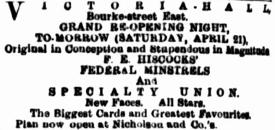AustLit
BiographyHistory
Most Referenced Works
Notes
-
PERSONNEL:
1. Performers (comedians/singers/actors and sepcialty acts etc): Edward Amery (1883-1886), W. A. Ball (1884-1886), Walter T. Bates (1883), W. Horace Bent (1883-1889), Thomas Bergin (1883), Louis Braham (1883-1886), Harry Carroll (1884-1885, 1888), Johnny Cowan (1884), Sam Dearin (1883), Johnny Gardner (1883), Joseph Haverly (1883), Charles Heywood (1883), Charles Holly (1883), George Jones (1883), Sam Keenan (1884-1888), E. J. Kennedy (1883), George W. Lawless (1883), Alf Lawton (1883), Charles McCarthy (1883), John Maccohniois (1883), Alf Moynham (1884-1886), J. S. Porter (1884-1886), Beaumont Read ((1884-1886), James E. Richardson (1883), George Turner (1883-1888), J. S. Whitworth (1883, 1885), Edward Williamson (1883).
2. Musicians (incl. music directors): Owen Conduit (piano), Nicholas La Feuillade (violin/ music director).
3. Short term and/or guest artists included M. Clune (1884), Harry Crawford (1888), E. C. Dunbar (1885), Harry W. Emmet (1883), Tommy Empson (1993), Mrs T. Empson (1883), T. Gall (1885), J. Harris (1884), W. Jones (1884), Thomas H. Rainford (1883-1884), George Smith (1883), Walter Wiseman (1885).
4. The following performers (who do not have entries in AustLit) are known to have been associated with other Australian and non-Australian minstrel companies:
- Edward Amery: US and Mammoth Minstrels.
- Lou Braham: Moore and Burgess Minstrels / Birch and Backus Minstrels.
- Sam Dearin: Haverley's Minstrels (USA, c1870s-1880s).
- G. W. Lawless: Billy Emerson's Minstrels.
5. Engagements chronologies for the following performers (who also do not have entries in AustLit) are included in Clay Djubal's "What Oh Tonight" Appendices. See Appendix A.
- Johnny Cowan
- Johnny Gardner
- J. S. Porter
-
This entry has been sourced from research undertaken by Dr Clay Djubal into Australian-written popular music theatre (ca. 1850-1930). See also the Australian Variety Theatre Archive


